The Luke Fisher Memorial Ward, Lytham Hospital.
A new wing was added to the hospital which opened in
1901.

Architectural plan of the Luke Fisher Memorial
Ward.
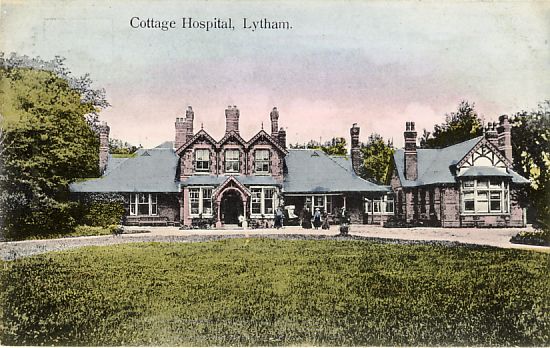
Lytham Cottage Hospital with the Luke Fisher
Memorial Ward to the right c1903.
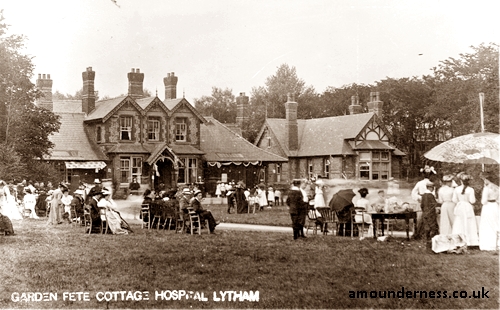
Until the transfer of the hospital to the National
Health Service in 1948 it was funded by subscriptions, contributions and events
such as the annual garden fete, church collections and golf
competitions.
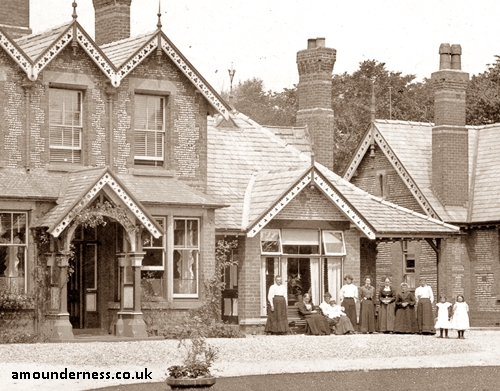
Patients outside the hospital c1910.
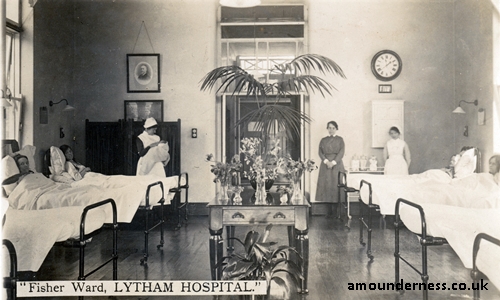
The Fisher Ward c1910 with a photo of Dr. Luke
Fisher and his memorial plaque to the left.
|
1914-18 War
The first wartime casualties arrived in Lytham in
October 1914 but they were Belgian soldiers and it is thought
that they were all treated at the newly opened Bannister Military
Hospital on East Beach.
A small number of British casualties were treated at
Lytham Cottage Hospital from November 1914 into 1915 but it isn't clear what
happened after that. There was at this time no hospital in St
Annes-on-Sea which was dependent on Lytham so there was very little
capacity for wounded soldiers.
A number of Red Cross and army hospitals opened in
Lytham and St Annes, these were:
Bannister House Military
Hospital, East Beach, Lytham (1914) Belgian Soldiers.
Chaseside Hospital, Headroomgate, St
Annes-on-Sea (1914) Belgian Soldiers and then British.
King's Lancashire Military Hospital,
Squires Gate, St Annes (1915) British & Empire Soldiers.
Pembroke House
Auxiliary Hospital, Ansdell, Lytham (1915) British Soldiers.
Chaseside Hospital, St George's
Square, St Annes-on-Sea (1916) British Soldiers.
Starr Hills Auxiliary
Hospital, Ansdell, Lytham (1916)
Imperial Hydro Military
Convalescent Hospital (1917) British Officers only.
|
|
Blackpool Gazette & Herald - Friday 02 October 1914
LYTHAM. The Lytham Cottage Hospital has offered eight beds
for the reception of the wounded soldiers, and Mrs. J. T. Clifton has very
generously offered to contribute 5s. per head of the weekly cost of maintenance
for an indefinite period. This means £2. per week for several months, and Mrs.
Clifton's kind offer is greatly appreciated.
|
Belgian Wounded
About October 1914 the Matron of Lytham Cottage
Hospital left to take charge of the newly opened Bannister House Military
Hospital at East Beach, Lytham. This had been set up to treat Belgian wounded
soldiers. Many still thought that the War would be over by Christmas.
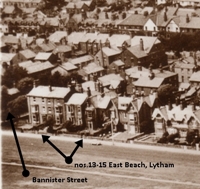
|
|
Blackpool Gazette & Herald - Friday 20 November 1914
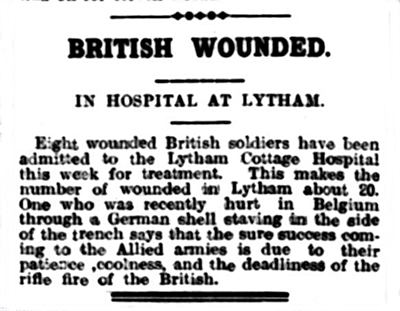
|
|
Northampton Mercury - Friday 20 November 1914
SOLDIERS’ STORIES.
Local Men’s Narrow Escapes.
We publish this week another interesting series letters
which give a vivid idea of the eventful experiences and narrow escapes which
have befallen some our local men who are either at present in the fighting line
or recovering from the effects of their contact with the enemy.
COSTLY WORK FOR THE “STEELBACKS.”
Private E. G. Edwards, of Rushden one the "Steelbacks" who
is now in the Cottage Hospital, Lytham, Lancs, writing home,
says : "It does seem strange here now after being out in Belgium, where every
civilian we see is fleeing for his life.
‘‘On Wednesday last week we had the stiffest fight
that has ever been recorded. There were 16 new regiments from Germany in
front of us. They had an order to break our lines at all costs, and the new
regiments were Prussian Guards, the Kaiser’s own body guards. Well, what
did they do? They flung themselves at us in thousands to overwhelm us in
numbers."
We waited in our trenches for them with our blood
boiling to get at them, until they got ten yards from us, when we sent
volley into them, and the first four lines went down as if they had fallen
on purpose, but most of them were dead. Still they came on, driven by their
officers with sword and revolver, but they ran into certain death—it was
terrible!
There were thousands came on, but only a few
returned to the German lines. Well, some of them got through our line, and
we had to go and drive them back. This was the work that cost the Northants
a hundred lives. I'll tell you more when I see you.
I got wounded on Friday last at 4.30 in the morning.
The enemy started to fire at us in our trenches, and we couldn't see where
the shots were coming from.
We were going to fix our bayonets in case they
rushed our trench, and that is when I got shot. In getting my rifle I had
to put my hand above the trench, and had two bullets through each finger.
It is not very serious. I'll be better soon and back at the front. I don't
suppose there is any chance of getting home for my 21st birthday."
|
|
Kington Times - Saturday 09 January 1915
LOCAL CASUALTIES.
LEOMINSTER MAN WOUNDED.
At the beginning of the week Mrs. Jones, of 70, Bridge
Street, Leominster, received notification that her son, Pte. John Jones, of the
South Wales Borders, had been wounded while serving at the front.
In a letter from the Cottage Hospital,
Lytham, to which he has been conveyed, Pte. Jones stated that he was
wounded in the leg and that both his feet were frost-bitten, but that be was
going on well.
He also says that just after receiving his Xmas parcel in
the trenches a shell came and as a result he was buried in the trench, all the
things he had received being covered with the dirt and lost. Previous to being
sent to England he was in a hospital at Havre.
In another letter just received from Pte. Jones he writes
that he got up on Wednesday for the first time and although he felt weak
thought he would soon get his strength back, as the wounded in [Lytham]
hospital were very well looked after.
|
| |
|
|